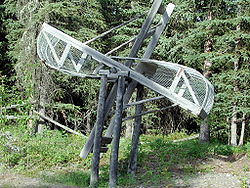
Fish wheel
Encyclopedia

Alaska
In Alaska, fish wheels are allowed only along the Copper RiverCopper River
Copper River may refer to:*Copper River , in the United States.*Copper River , in the United States.*Copper River , a tributary of the Skeena River in Canada....
and the Yukon River
Yukon River
The Yukon River is a major watercourse of northwestern North America. The source of the river is located in British Columbia, Canada. The next portion lies in, and gives its name to Yukon Territory. The lower half of the river lies in the U.S. state of Alaska. The river is long and empties into...
. When not in operation, the wheels are lifted out of the water.
The wheels primarily catch salmon
Salmon
Salmon is the common name for several species of fish in the family Salmonidae. Several other fish in the same family are called trout; the difference is often said to be that salmon migrate and trout are resident, but this distinction does not strictly hold true...
and can be owned by more than one person. All salmon caught using a fish wheel must be reported to the Alaska Department of Natural Resources
Department of Natural Resources
Many sub-national governments have a Department of Natural Resources or similarly named organization:Australia*Queensland Department of Natural Resources and MinesCanada*Natural Resources Canada*New Brunswick**New Brunswick Department of Natural Resources...
(DNR) and must be prepared due to state fishing guidelines. The type of salmon caught varies with the time of year because not all salmon migrate and spawn at the same time. Typically, by the time a salmon reaches the Yukon River fish wheels, the fish are damaged, and salmon which enter the fish wheels on the Copper River are considered better quality. Most salmon caught with Yukon River fish wheels are used as food for sled dogs.
Columbia River fishery
Fish wheels were tremendously effective in the Columbia RiverColumbia River
The Columbia River is the largest river in the Pacific Northwest region of North America. The river rises in the Rocky Mountains of British Columbia, Canada, flows northwest and then south into the U.S. state of Washington, then turns west to form most of the border between Washington and the state...
around the turn of the 20th Century. One single fish wheel near The Dalles pulled 418,000 pounds of salmon out of the river in 1906 alone, and it was just one of more than 75 fish wheels working the river that year.
Conventional wisdom largely blames fish wheels for the decimation of the salmon run up the Columbia River in Oregon
Oregon
Oregon is a state in the Pacific Northwest region of the United States. It is located on the Pacific coast, with Washington to the north, California to the south, Nevada on the southeast and Idaho to the east. The Columbia and Snake rivers delineate much of Oregon's northern and eastern...
and Washington during the first few decades of the 20th Century. At the time, a bitter public-relations battle was fought between the gillnet
Gillnet
Gillnetting is a common fishing method used by commercial and artisanal fishermen of all the oceans and in some freshwater and estuary areas. The gillnet also is used by fisheries scientists to monitor fish populations. Because gillnets can be so effective their use is closely monitored and...
fishing boat operators of the lower Columbia and the fish-wheel operators farther upstream; each group blamed the other for its dwindling salmon catch. In the 1908 Oregon election, the two sides sponsored competing ballot measures, one banning fish wheels and the other making gillnetting virtually illegal; both passed, but were thrown out by courts.
Fish wheel operations on the Columbia were finally banned in 1928 (Oregon) and 1935 (Washington). But by this time the Grand Coulee Dam
Grand Coulee Dam
Grand Coulee Dam is a gravity dam on the Columbia River in the U.S. state of Washington built to produce hydroelectric power and provide irrigation. It was constructed between 1933 and 1942, originally with two power plants. A third power station was completed in 1974 to increase its energy...
had been built without fish ladders, cutting off access to many spawning grounds. This may be the reason the fishery has never rebounded to its historic levels.

